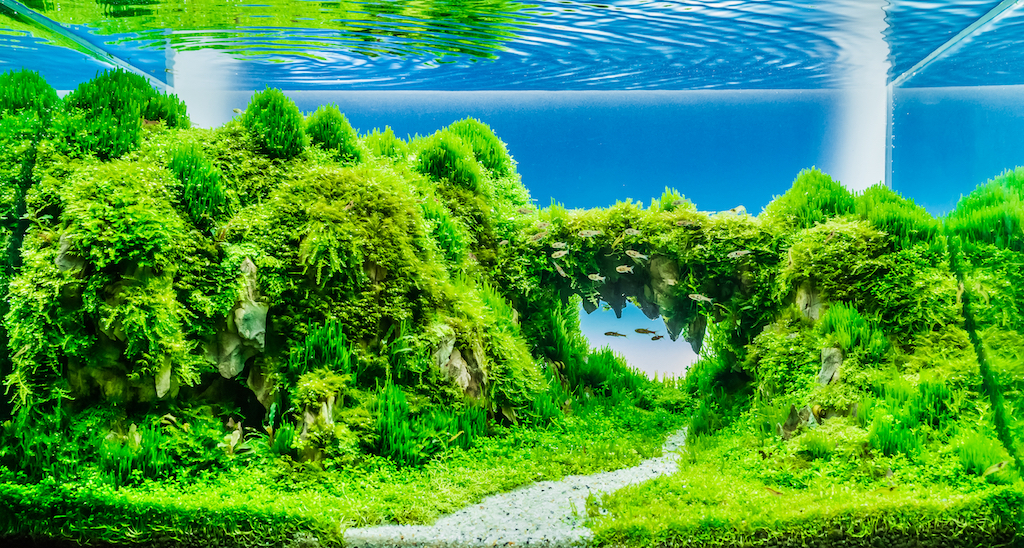Have you ever wondered how people make stunning waterscapes in their aquariums? It’s all about aquascaping. This article will discuss aquascaping, the different styles, and what you need to start aquascaping? Let’s dive in.
*This post contains compensated links. Find more info in my DISCLAIMER. As an Amazon Associate, I earn from qualifying purchases.
What Is Aquascaping?
Aquascaping is the art of decorating and arranging aquatic plants, stones, cave works, driftwoods, and rocks in an aesthetical way inside an aquarium. Typically, you can refer to aquarium aquascaping as underwater landscaping.
The main aim of aquascaping an aquarium is to create artful underwater landscapes. There are numerous aquascaping ideas and distinctive styles to incorporate in aquarium landscaping.
Though fish and aquascaping plants are the most common, you can have a mini aquascape that has rocks, stone, and driftwood even without plants. Depending on your preference, you can do fish alone, plants, or combine the two.
You can also create a unique aquascaping design. A bonsai aquascape can bring beauty and a real level of intrigue to the home.

Benefits of Aquascaping
Aquascaping is mostly a hobby for many people. Our life today is associated with numerous sources of stress. By spending time doing what you love, you take some time for yourself, forcing your mind to ward off depression and release stress.
Aquascaping can encourage you to stretch your imagination and creativity. You can create a unique aquascaping design using the various supplies available. In addition, you become physically active and increase your daily productivity.
You can also teach your kids how to aquascape. Aquascaping will positively impact them and spur their curiosity. It offers an exciting learning opportunity.
A landscaped aquarium brings a beautiful ambiance and becomes the focal point of any room. Watching the stunning view of the aquascape calms the mind and lowers blood pressure.
Aquascaping Styles
There are different types of aquascaping, each with its unique characteristics. Here are the four main types:
Dutch-style Aquascaping
Dutch-style aquascaping is the oldest and became popular in the 1930s in the Netherlands. It focuses on the growth and arrangement of aquascaping plants. Usually, it does not incorporate aquascaping rocks, driftwood aquascape, or any hardscape material.
Plant selection and placement are essential for this aquascaping design because they allow the different aquatic plants to complement each other in shape and color. Therefore, deep knowledge of aquascaping plants and how to plant and arrange them to create an appealing view is necessary.
The basic construction technique in Dutch-style aquascaping is the terracing approach. The common practice is to plant about 70 percent of the aquarium space. Plant no more than a single plant species per four inches of tank length to avoid duplication.
Iwagumi Aquascape
Iwagumi is a Japanese style aquascaping that requires extensive knowledge and experience to implement and maintain. The Japanese word “iwagumi” literally translates to “rock formation.”
Rocks for aquascaping act as the structures for this style. You can utilize any number of stones, but it must be an odd number to avoid symmetry.
The aim is to arrange a group of similar rocks in texture and color but with varying outlines and shapes. You should position the aquascaping rocks in a fluent, spacious way and intertwine them to the aquascape and with each other.
You can also incorporate fish and plants into this aquascape style. However, they should preserve the open space and not overshadow the rocks.
Nature Aquascape
Nature aquascaping is among the most popular aquascaping ideas in the world. It involves imitating the natural landscape to create a more natural feel and look. Nature aquascaping is about creating complexity, interesting visual contrast, and tension.
Aquascaping forest is the most common nature aquascape. It depicts underwater versions of forests, hillsides, mountains, valleys, or beaches. Both hardcore materials, such as rocks and driftwood, combined with plants play an essential role in maintaining balance in the aquarium.
The biggest drawback of nature aquascape is that you will often encounter algae outbreaks. You will also need constant trimming to maintain the shape.
Jungle Aquascaping
Jungle style is easy to replicate and the best aquascaping for beginners. It is a bit of a combination of Nature and Dutch-style aquascaping. However, as the name suggests, it resembles a wild ecosystem that is natural and boundless.
In this style, plants are left on their own to grow naturally and spontaneously. The plants cover so densely, and the aquarium achieves a balance over time. Jungle aquascaping is a low-tech aquascape that requires less maintenance.
The jungle style has little or no hardscape and has less open space. Though it is not the most complex style, it can be very aesthetic once established.
What Is Needed For Aquascaping?
There are basic aquascaping supplies and tools you will need to get started. In addition, aquascaping requires some knowledge and effort.
You will need to invest some time in cleaning and maintaining your aquascape. Algae will soon take over if you fail to care for your aquascaping plants and animals.
You should also consider that your mini aquascape, filled with water and additional hardscape, has weight. Plan for an excellent long-term spot because it will not be easy to move around.
Here are some essential aquascaping supplies that you will need:
A Tank Or Aquarium
The first thing you will require is an aquarium itself. Nano aquariums are getting popular and are perfect for setting up a low-tech aquascape. Such a mini aquascape is easy to maintain and does not take up much space.
Water Filter
A water filter is essential for filtering small particles. You can choose from the different types to determine which best suits your setup. Water filters also add movement to the water, which is nice to look at.
Light And Carbon Dioxide
A light source and carbon dioxide are essential for the plants’ growth. Light also adds to the aesthetics by providing a pleasant and healthy color. LEDs are the most common because they are durable, flexible, and energy-saving.
Aquascaping Tools
You will need a few aquascaping tools to help you maintain your aquarium. The essential tools include scissors, tweezers, and a carbon dioxide indicator.
Aquascaping Design Basics
Aquascaping may seem difficult to accomplish, but the entire process becomes straightforward with simple design basics and rules. Here are some basic aquascaping rules:
Rule Of Thirds
Aquascaping involves creating aesthetic visuals. The rule of thirds involves using imaginary guidelines to know where to place certain elements within our aquariums. This rule allows us to control what the viewer sees.
The rule of thirds allows you to identify the focal points of the aquarium, making the viewers’ visual experience more pleasing, captivating, and relaxing.
The Golden Ratio
The golden rule is connected to the creation of focal points in art, mathematics, and nature. In aquascaping, it is the point the viewers direct their eyes at first glance.
Creating Focal Points
A focal point is the anchor of the viewer’s mind. It gives the viewer a basic idea of where to start looking and where to go from there. Every aquascaping design should have at least a single focal point.
Aquascaping requires some knowledge and skills to get started and can be challenging for beginners. However, this aquascaping guide for beginners makes it pretty simple.
